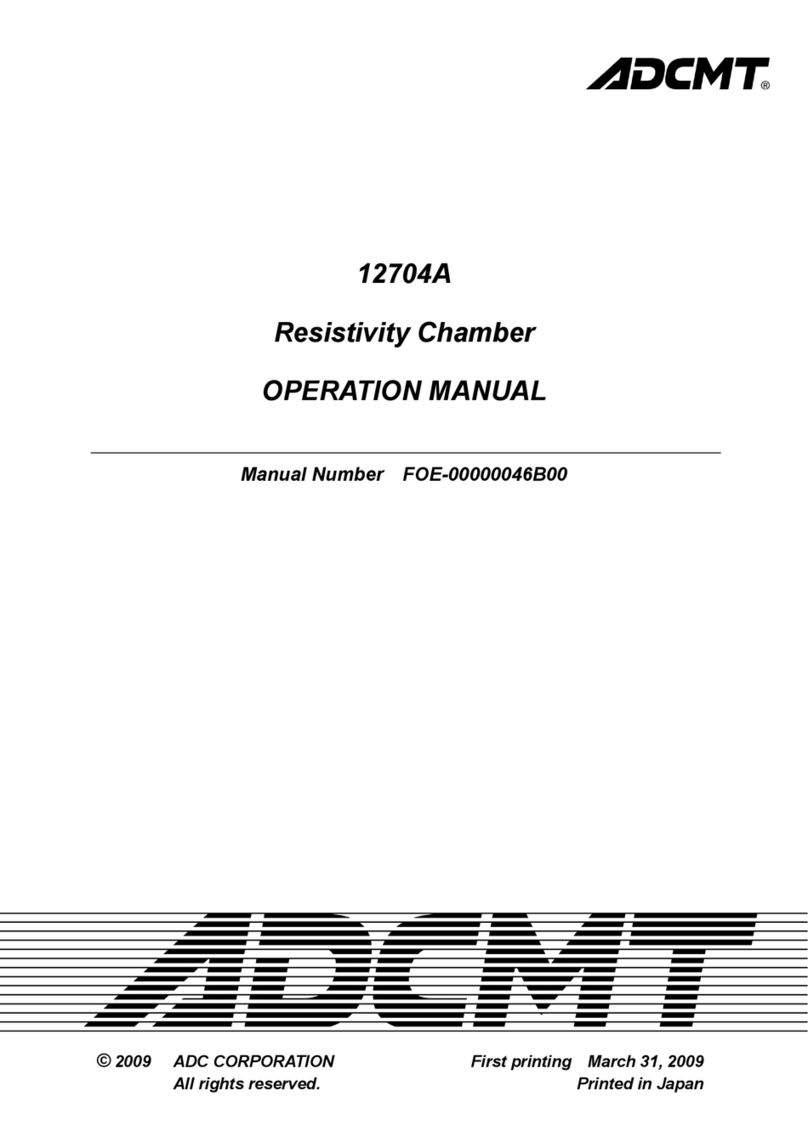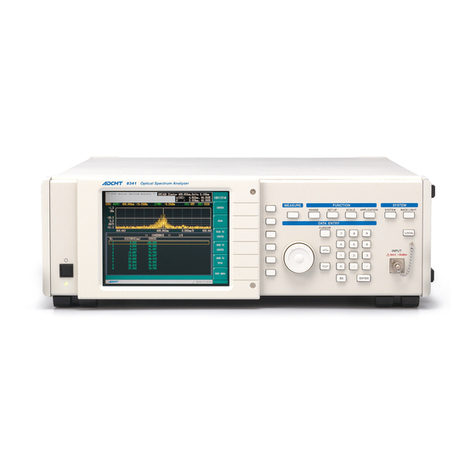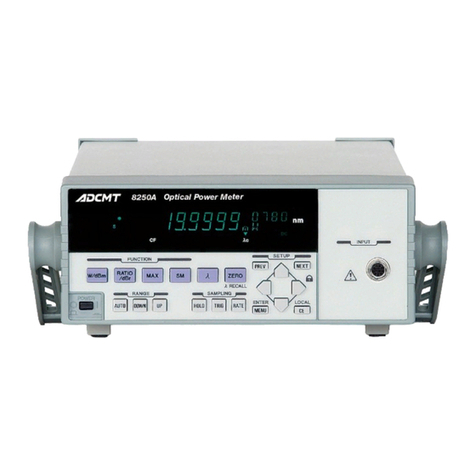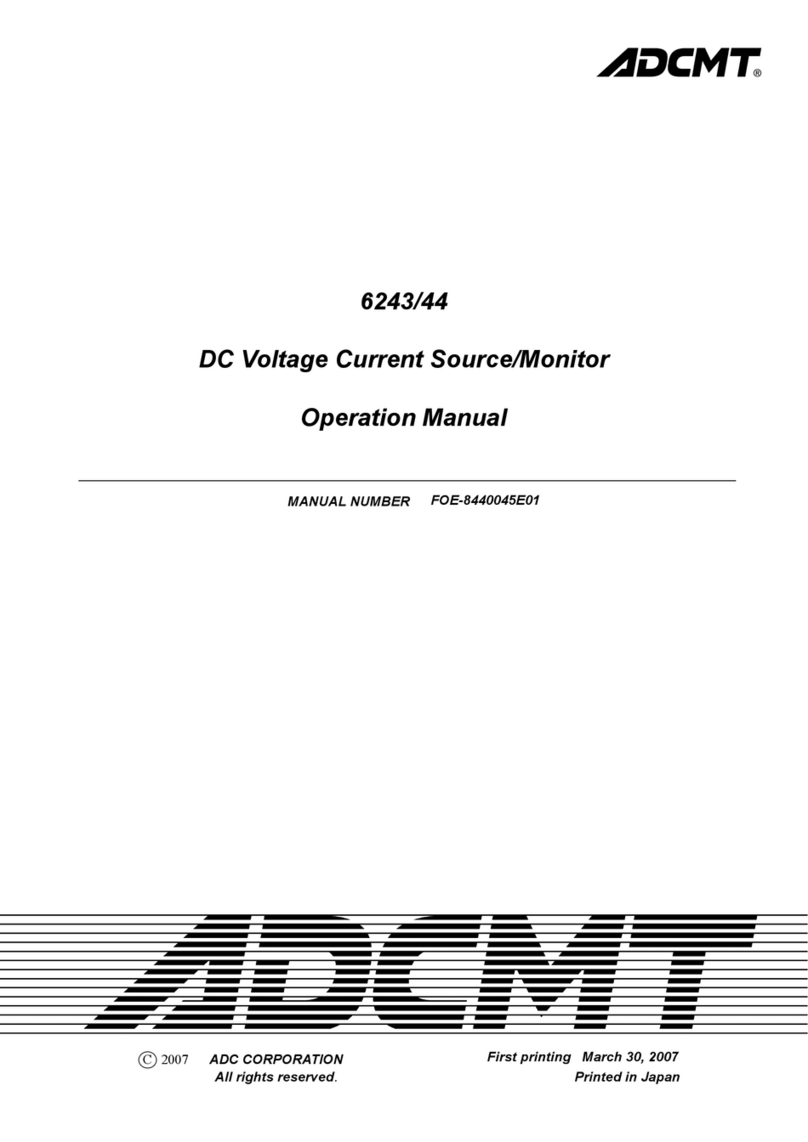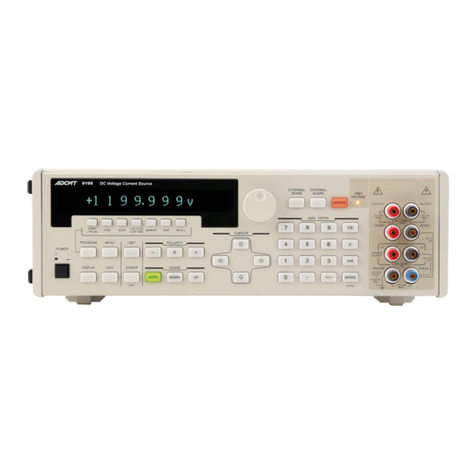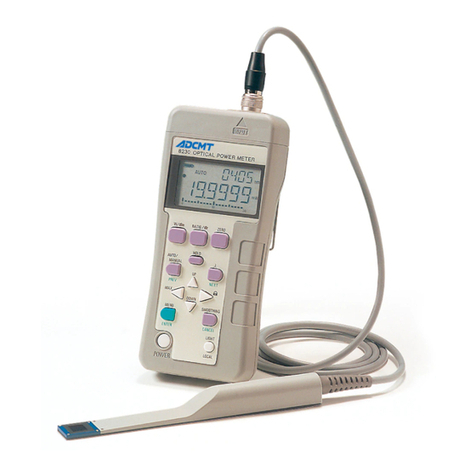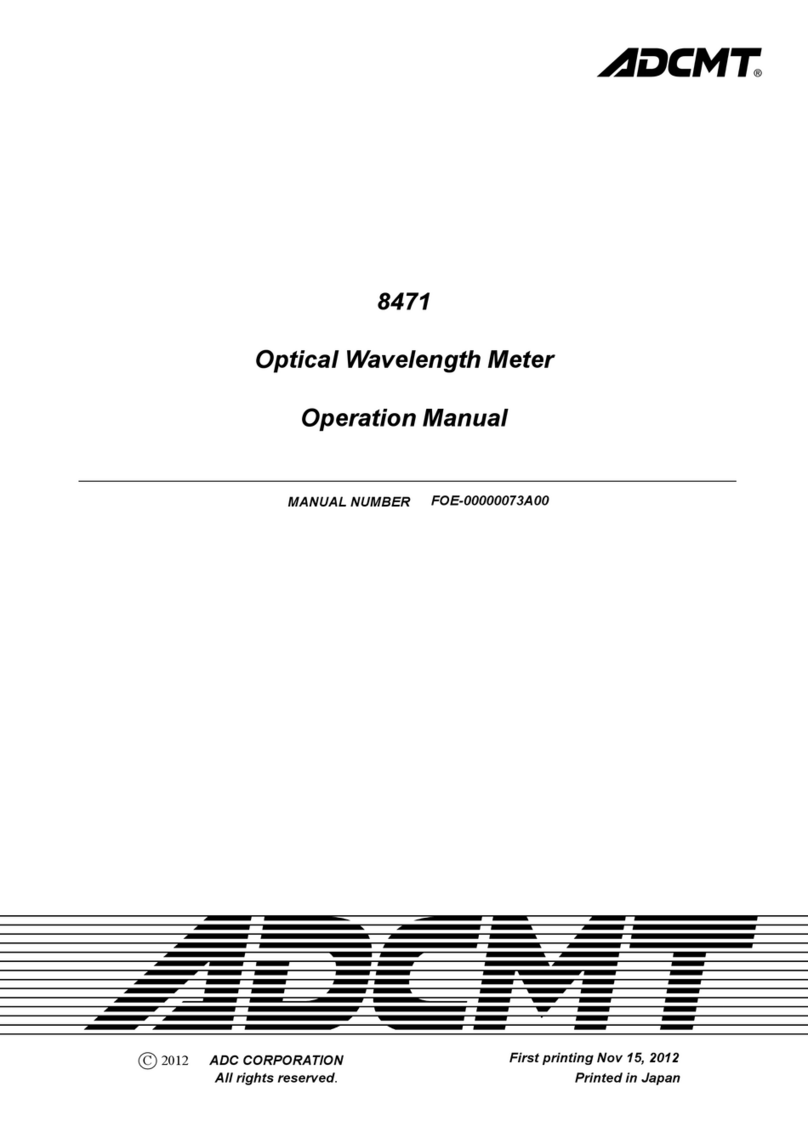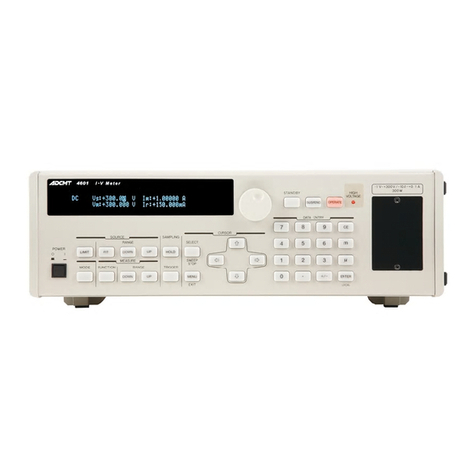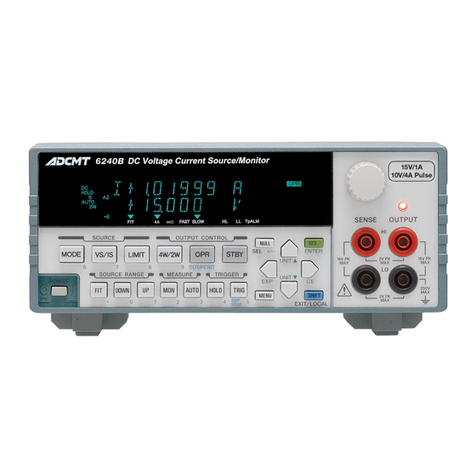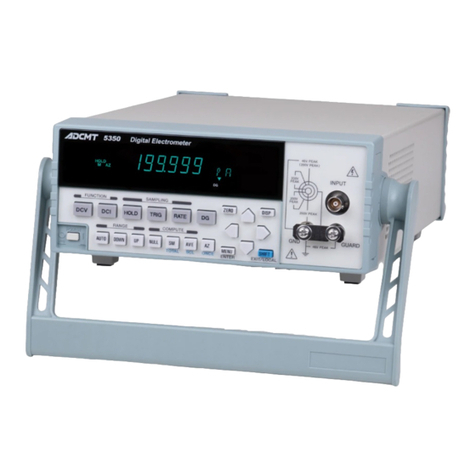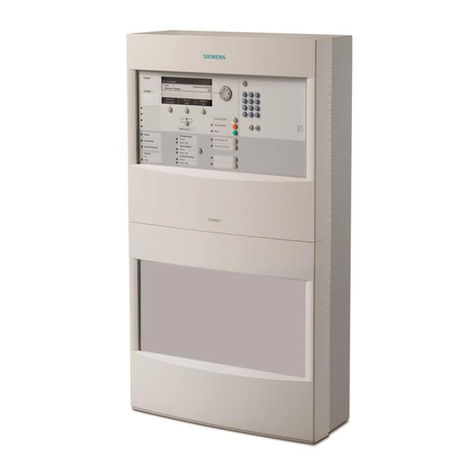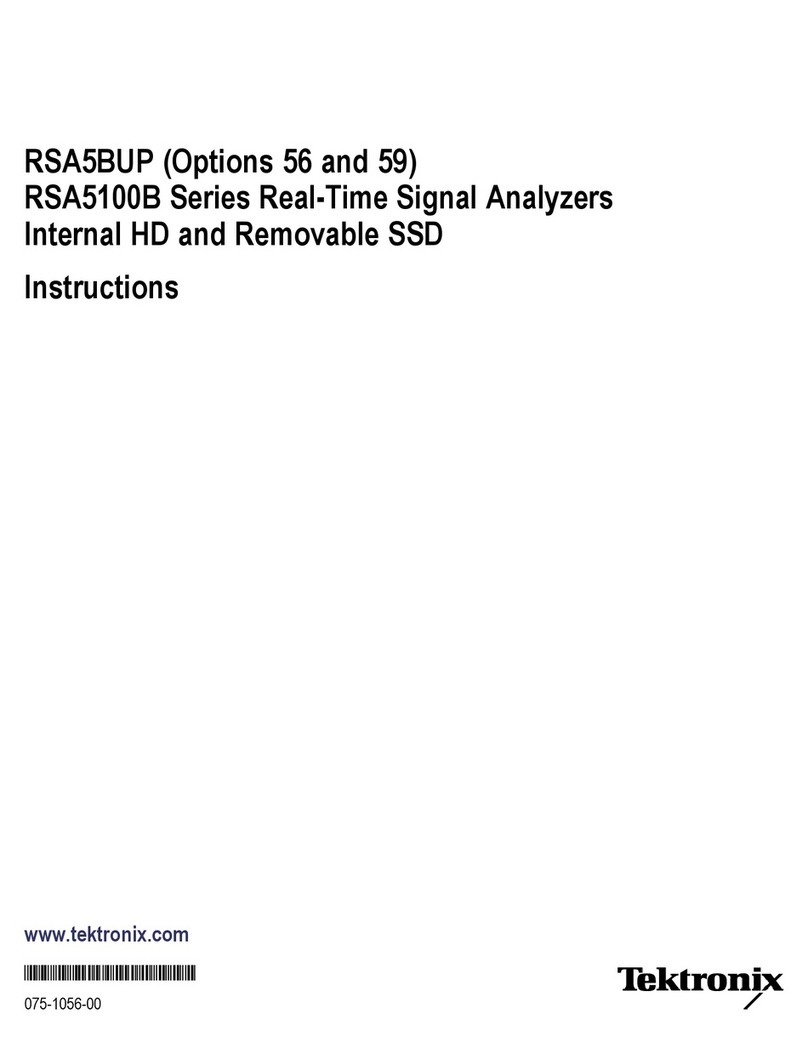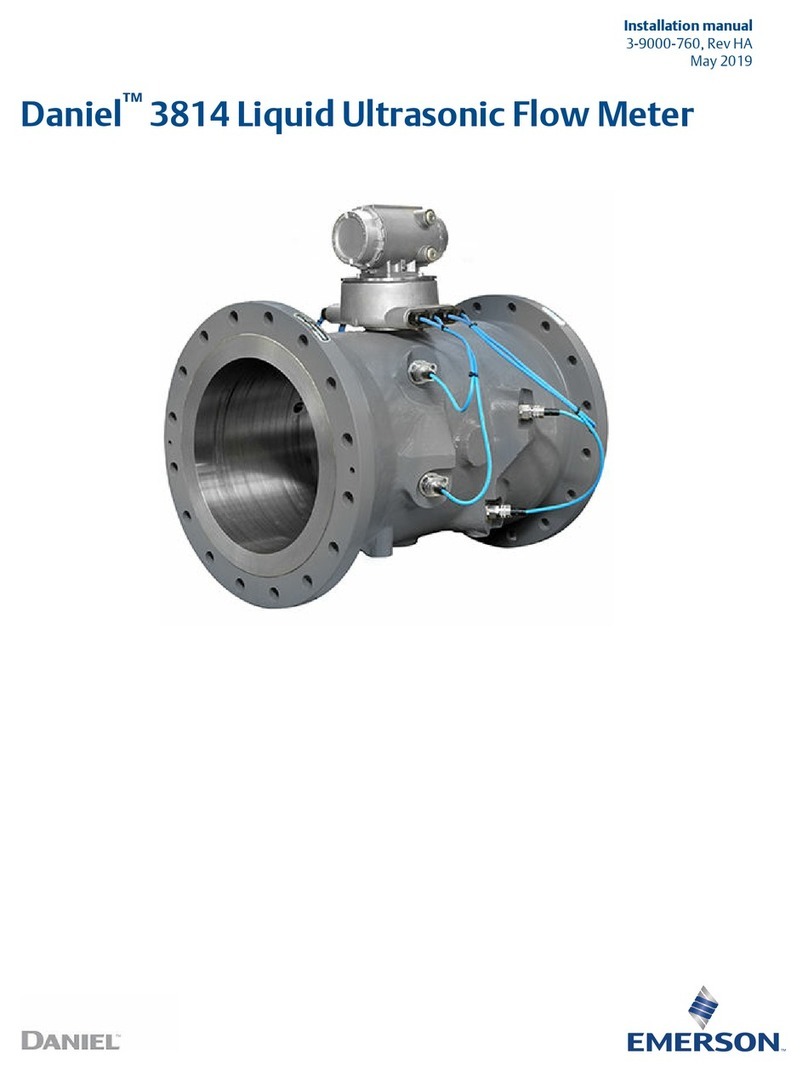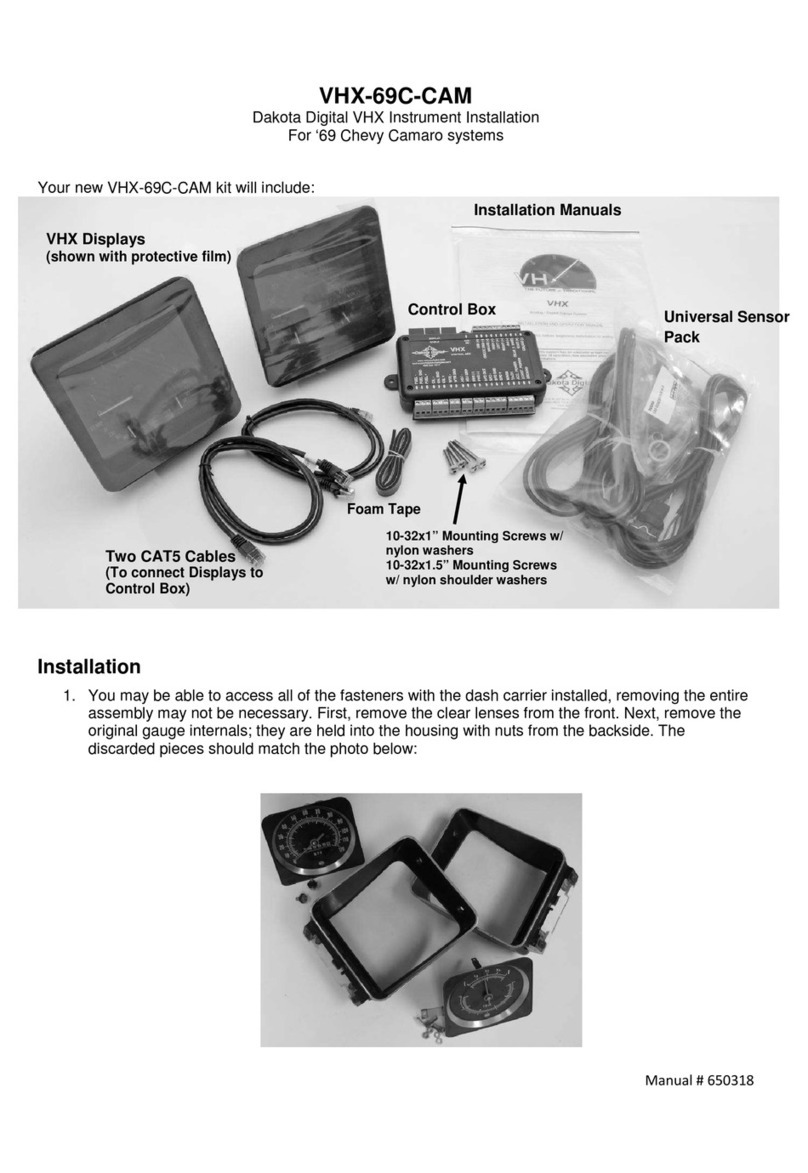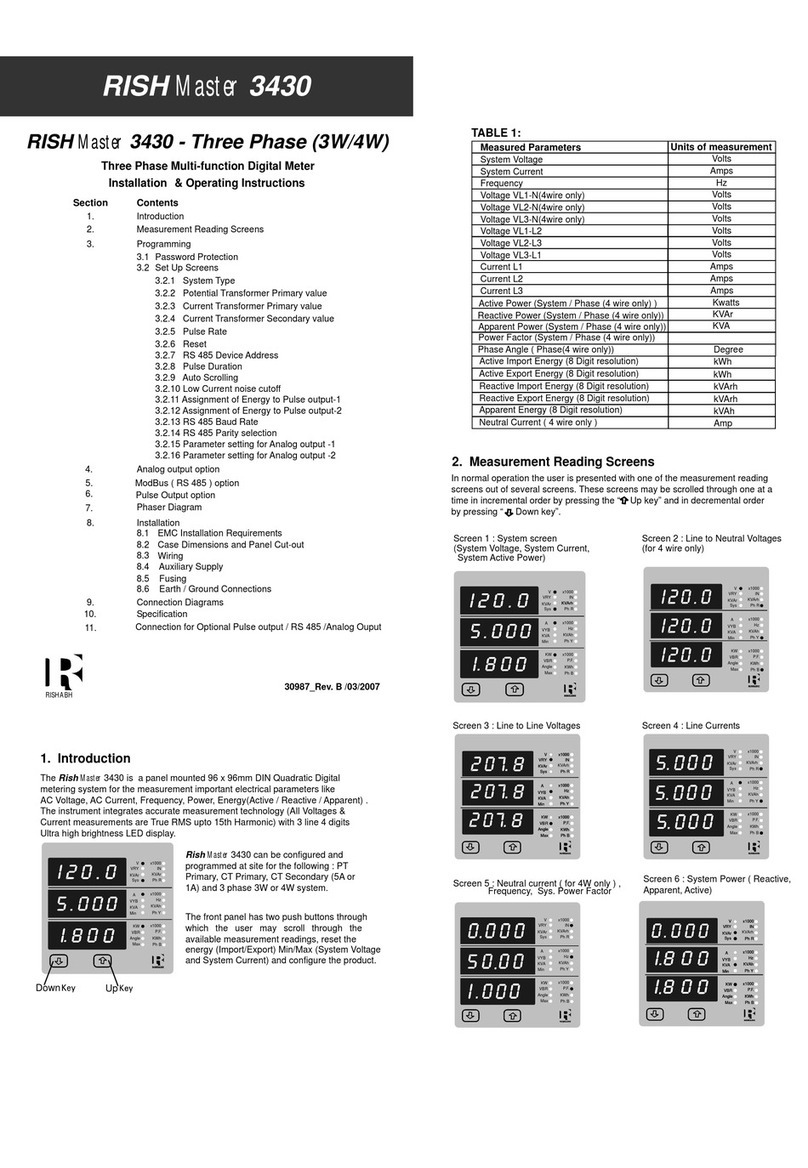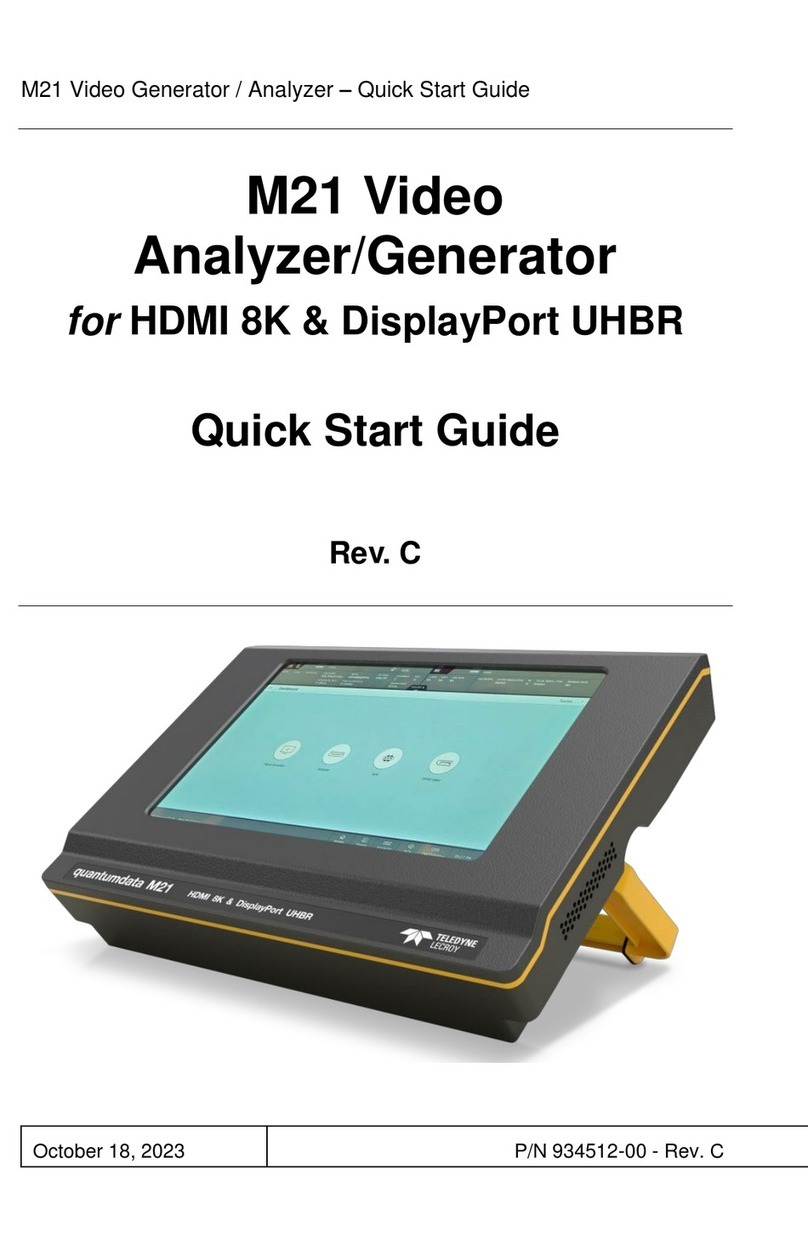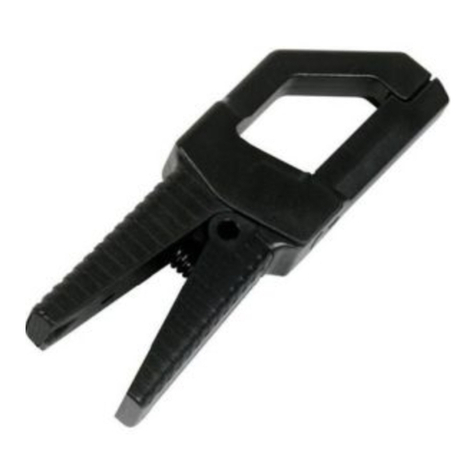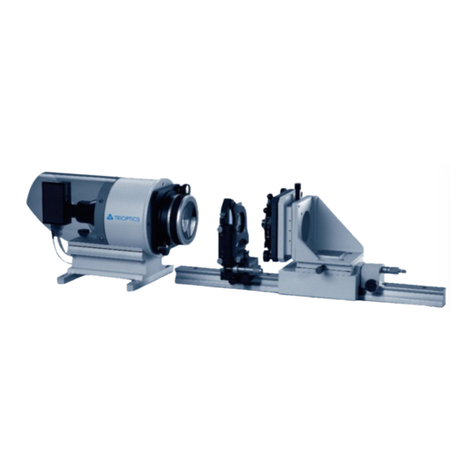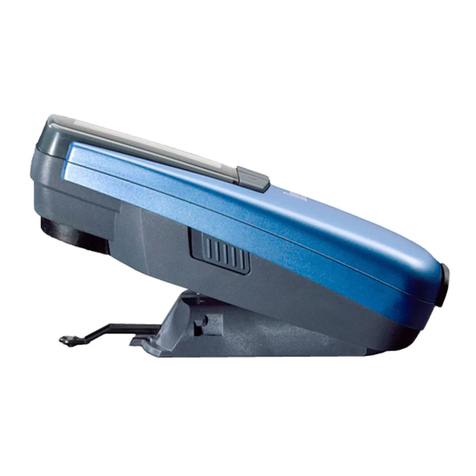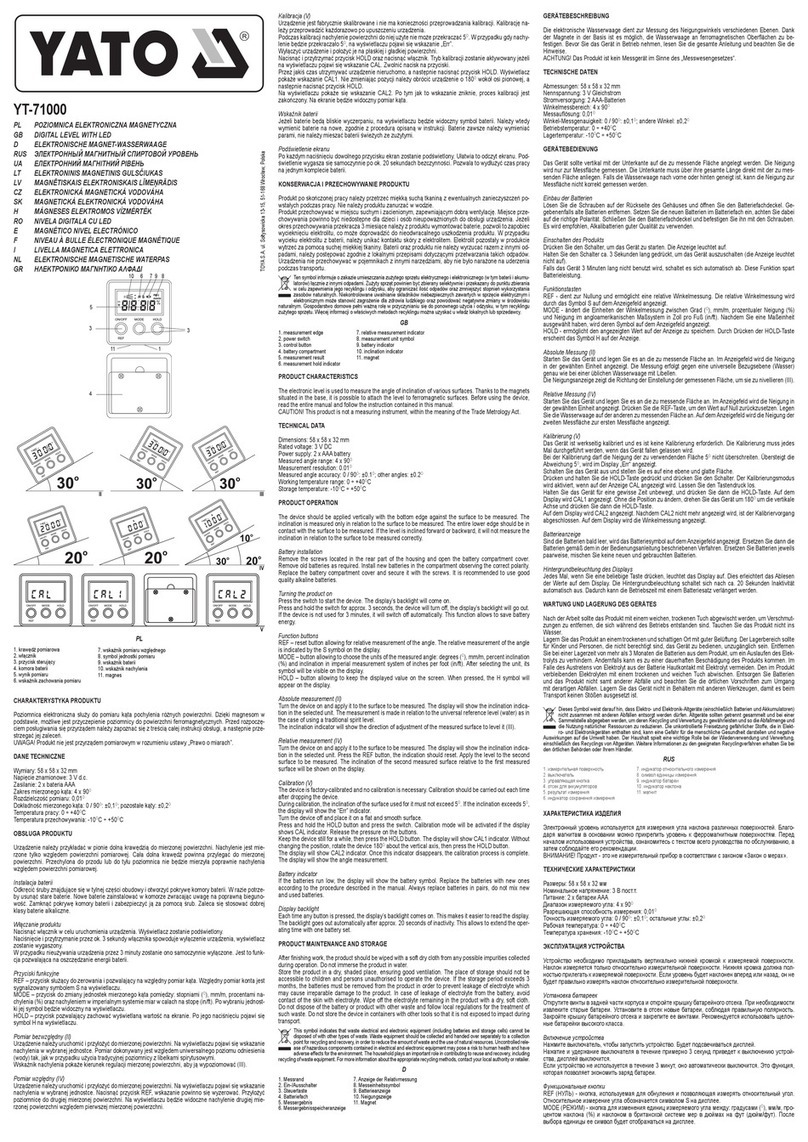ADCMT 8230E User manual

MANUAL NUMBER
C
Printed in Japan
ADC CORPORATION
All rights reserved.
8230E
Optical Power Meter
Operation Manual
FOE-8440174F01
First printing March 30, 2007
2007
Cover


Safety-1
Safety Summary
FOE-ANZENA00
To ensure thorough understanding of all functions and to ensure efficient use of this instrument, please read the
manual carefully before using. Note that ADC Corporation (hereafter referred to as ADC) bears absolutely no re-
sponsibility for the result of operations caused due to incorrect or inappropriate use of this instrument.
If the equipment is used in a manner not specified by ADC, the protection provided by the equipment may be im-
paired.
• Warning Labels
Warning labels are applied to ADC products in locations where specific dangers exist. Pay care-
ful attention to these labels during handling. Do not remove or tear these labels. If you have any
questions regarding warning labels, please ask your nearest ADC dealer. Our address and phone
number are listed at the end of this manual.
Symbols of those warning labels are shown below together with their meaning.
DANGER: Indicates an imminently hazardous situation which will result in death or serious
personal injury.
WARNING: Indicates a potentially hazardous situation which will result in death or serious
personal injury.
CAUTION: Indicates a potentially hazardous situation which will result in personal injury or
a damage to property including the product.
• Basic Precautions
Please observe the following precautions to prevent fire, burn, electric shock, and personal inju-
ry.
• Use a power cable rated for the voltage in question. Be sure however to use a power cable
conforming to safety standards of your nation when using a product overseas.
• When inserting the plug into the electrical outlet, first turn the power switch OFF and then
insert the plug as far as it will go.
• When removing the plug from the electrical outlet, first turn the power switch OFF and then
pull it out by gripping the plug. Do not pull on the power cable itself. Make sure your hands
are dry at this time.
• Before turning on the power, be sure to check that the supply voltage matches the voltage
requirements of the instrument.
• Connect the power cable to a power outlet that is connected to a protected ground terminal.
Grounding will be defeated if you use an extension cord which does not include a protective
conductor terminal.
• Be sure to use fuses rated for the voltage in question.
• Do not use this instrument with the case open.
• Do not place anything on the product and do not apply excessive pressure to the product. Al-
so, do not place flower pots or other containers containing liquid such as chemicals near this
Safety Summary

Safety Summary
Safety-2 FOE-ANZENA00
product.
• When the product has ventilation outlets, do not stick or drop metal or easily flammable ob-
jects into the ventilation outlets.
• When using the product on a cart, fix it with belts to avoid its drop.
• When connecting the product to peripheral equipment, turn the power off.
• Caution Symbols Used Within this Manual
Symbols indicating items requiring caution which are used in this manual are shown below to-
gether with their meaning.
DANGER: Indicates an item where there is a danger of serious personal injury (death or seri-
ous injury).
WARNING: Indicates an item relating to personal safety or health.
CAUTION: Indicates an item relating to possible damage to the product or instrument or relat-
ing to a restriction on operation.
• Safety Marks on the Product
The following safety marks can be found on ADC products.
: ATTENTION - Refer to manual.
: Protective ground (earth) terminal.
: DANGER - High voltage.
: CAUTION - Risk of electric shock.
• Replacing Parts with Limited Life
The following parts used in the instrument are main parts with limited life.
Replace the parts listed below before their expected lifespan has expired to maintain the perfor-
mance and function of the instrument.
Note that the estimated lifespan for the parts listed below may be shortened by factors such as
the environment where the instrument is stored or used, and how often the instrument is used.
The parts inside are not user-replaceable. For a part replacement, please contact the ADC sales
office for servicing.
Each product may use parts with limited life.
For more information, refer to the section in this document where the parts with limited life are
described.

Safety Summary
Safety-3
FOE-ANZENA00
Main Parts with Limited Life
• Hard Disk Mounted Products
The operational warnings are listed below.
• Do not move, shock and vibrate the product while the power is turned on.
Reading or writing data in the hard disk unit is performed with the memory disk turning at a
high speed. It is a very delicate process.
• Store and operate the products under the following environmental conditions.
An area with no sudden temperature changes.
An area away from shock or vibrations.
An area free from moisture, dirt, or dust.
An area away from magnets or an instrument which generates a magnetic field.
• Make back-ups of important data.
The data stored in the disk may become damaged if the product is mishandled. The hard disc
has a limited life span which depends on the operational conditions. Note that there is no
guarantee for any loss of data.
• Precautions when Disposing of this Instrument
When disposing of harmful substances, be sure dispose of them properly with abiding by the
state-provided law.
Harmful substances: (1) PCB (polycarbon biphenyl)
(2) Mercury
(3) Ni-Cd (nickel cadmium)
(4) Other
Items possessing cyan, organic phosphorous and hexadic chromium
and items which may leak cadmium or arsenic (excluding lead in sol-
der).
Example: fluorescent tubes, batteries
Part name Life
Unit power supply 5 years
Fan motor 5 years
Electrolytic capacitor 5 years
LCD display 6 years
LCD backlight 2.5 years
Floppy disk drive 5 years
Memory backup battery 5 years

Environmental Conditions
Safety-4 FOE-ANZENA00
This instrument should be only be used in an area which satisfies the following conditions:
• An area free from corrosive gas
• An area away from direct sunlight
• A dust-free area
• An area free from vibrations
• Altitude of up to 2000 m
Figure-1 Environmental Conditions
• Operating position
Figure-2 Operating Position
• Storage position
Figure-3 Storage Position
• The classification of the transient over-voltage, which exists typically in the main power supply, and
the pollution degree is defined by IEC61010-1 and described below.
Impulse withstand voltage (over-voltage) category II defined by IEC60364-4-443
Pollution Degree 2
Vibration
Direct sunlight
Corrosive
gas
Dust
Front
The instrument must be used in a hor-
izontal position.
To prevent the internal temperature
from rising, cooling fans are installed
in some instruments.
The air vents on the case must be un-
blocked.
A clear space of 10 centimeters or more
must be kept around the air vents.
Front
This instrument should be stored in a horizontal
position.
When placed in a vertical (upright) position for
storage or transportation, ensure the instrument is
stable and secure.
-Ensure the instrument is stable.
-Pay special attention not to fall.

Safety-5
Types of Power Cable
FOE-ANZENA00
Replace any references to the power cable type, according to the following table, with the appropriate power cable
type for your country.
Plug configuration Standards Rating, color
and length
Model number
(Option number)
PSE: Japan
Electrical Appliance and
Material Safety Law
125 V at 7 A
Black
2 m (6 ft)
Straight: A01402
Angled: A01412
UL: United States of America
CSA: Canada
125 V at 7 A
Black
2 m (6 ft)
Straight: A01403
(Option 95)
Angled: A01413
CEE: Europe
DEMKO: Denmark
NEMKO: Norway
VDE: Germany
KEMA: The Netherlands
CEBEC: Belgium
OVE: Austria
FIMKO: Finland
SEMKO: Sweden
250 V at 6 A
Gray
2 m (6 ft)
Straight: A01404
(Option 96)
Angled: A01414
SEV: Switzerland 250 V at 6 A
Gray
2 m (6 ft)
Straight: A01405
(Option 97)
Angled: A01415
SAA: Australia, New Zealand 250 V at 6 A
Gray
2 m (6 ft)
Straight: A01406
(Option 98)
Angled: ---------
BS: United Kingdom 250 V at 6 A
Black
2 m (6 ft)
Straight: A01407
(Option 99)
Angled: A01417
CCC:China 250 V at 10 A
Black
2 m (6 ft)
Straight: A114009
(Option 94)
Angled: A114109


8230E Optical Power Meter Operation Manual
Preface-1
PREFACE
This manual describes how to use the 8230E, its specifications, and how to use the 8230E by remote control.
1. Organization of this manual
This manual consists of the following chapters:
Safety Summary Read the safety instructions before operat-
ing this instrument.
1. INTRODUCTION Describes the following items: product
overview, accessories, operating environ-
ment, and precautions to be taken when
using this instrument. Read this chapter
before operating this instrument.
2. PANEL AND FUNCTION DESCRIPTION
• Front Side
• Rear Side
• Upper Side
• Bottom Side
Describes the names of each part of the
panel and their functions as well as the dis-
play section.
3. HOW TO PERFORM MEASUREMENTS
•MenuMap
• Menu Description
• Measurement Procedure
• Backing up and Initializing the Setting Parameter
The user can learn how to use this instru-
ment.
4. REMOTE CONTROLLING VIA USB Describes how to control this instrument
by remote. Example programs are pro-
vided.
5. TECHNICAL NOTES
• Principle of Measurement
• Optical Power Calibration and Wavelength Sen-
sitivity Correction
• ANALOG OUT
Describes supplementary technical infor-
mation on this instrument.
6. PERFORMANCE TEST
• Performance Test for the 8230E
• Measuring Instruments and Other Equipment
Required to Check the Performance of the Opti-
cal Sensor
Describes how to test the performance of
this instrument.
7. CALIBRATION Describes how to calibrate this instrument
to use it within the specified accuracy.
8. SPECIFICATIONS
• 8230E Specifications
• Optical Sensor Specifications
Describes the 8230E and optical sensor
specifications.
A.1 Trouble Shooting (Before Asking for Repair)
A.2 Error Messages
Describes messages which are displayed
on the 8230E and other information.
PREFACE

8230E Optical Power Meter Operation Manual
PREFACE
Preface-2
2. Notation
• The panel keys are described in this manual as shown below.
Panel key: In bold type Example: [ZERO], [RATIO/ dBr]
3. Trademarks and Registered Trademarks
• Microsoftand Windowsare trademarks or registered trademarks of Microsoft Corporation in the
United States and other countries.
• Other product and company names referenced herein are trademarks or registered trademarks of their
respective owners.

8230E Optical Power Meter Operation Manual
C-1
TABLE OF CONTENTS
1. INTRODUCTION ....................................................................................... 1-1
1.1 Product Outline ................................................................................................. 1-1
1.2 Standard Accessory ........................................................................................... 1-1
1.3 Accessories ........................................................................................................ 1-2
1.4 Connectable Sensors ......................................................................................... 1-3
1.5 Optical Power Meter Software Revisions and Applicable Optical Sensors ..... 1-6
1.6 Options and Accessories ................................................................................... 1-7
1.6.1 Option to Use Old-Type Sensors (OPT8230E+70) .................................... 1-7
1.6.2 Sensor Option ............................................................................................. 1-7
1.7 Operating Environment ..................................................................................... 1-8
1.8 Power Supply .................................................................................................... 1-8
1.8.1 AC Adaptor ................................................................................................ 1-8
1.8.2 Battery ........................................................................................................ 1-8
1.8.2.1 How to Remove and Replace Batteries ...................................................... 1-9
1.9 Precautions when Using This instrument .......................................................... 1-10
1.10 Checking Operations ......................................................................................... 1-10
1.11 Cleaning ............................................................................................................ 1-11
1.11.1 Cleaning the 8230E .................................................................................... 1-11
1.11.2 Cleaning the Incident Surface of the Sensor .............................................. 1-11
1.12 How to Store and Transport the Instrument ...................................................... 1-11
1.12.1 Storage ........................................................................................................ 1-11
1.12.2 Transportation ............................................................................................. 1-11
1.13 Warm-up ........................................................................................................... 1-12
1.14 Calibration ......................................................................................................... 1-12
1.15 Replacing Parts with Limited Life .................................................................... 1-12
1.16 Product Disposal and Recycle ........................................................................... 1-13
2. PANEL AND FUNCTION DESCRIPTION ........................................ 2-1
2.1 Front Side .......................................................................................................... 2-1
2.1.1 Function Description .................................................................................. 2-1
2.1.2 Display Description .................................................................................... 2-5
2.1.2.1 Battery Indicator ......................................................................................... 2-5
2.2 Rear Side ........................................................................................................... 2-6
2.3 Upper Side ......................................................................................................... 2-7
2.4 Bottom Side ....................................................................................................... 2-7
3. HOW TO PERFORM MEASUREMENTS .......................................... 3-1
3.1 Menu Map ......................................................................................................... 3-1
3.2 Menu Description .............................................................................................. 3-2
3.3 Measurement Procedure .................................................................................... 3-3
3.3.1 Connecting the Sensor ................................................................................ 3-3
3.3.2 Setting the Wavelength ............................................................................... 3-3
3.3.3 Zero Cancel ................................................................................................ 3-3
TABLE OF CONTENTS

8230E Optical Power Meter Operation Manual
Table of Contents
C-2
3.3.4 Setting the Range ........................................................................................ 3-3
3.3.5 Reading the Display ................................................................................... 3-3
3.4 Backing up and Initializing the Setting Parameter ............................................ 3-4
3.4.1 Backing up the Setting Parameter .............................................................. 3-4
3.4.2 How to Initialize ......................................................................................... 3-5
3.5 Wavelength Preset ............................................................................................. 3-6
3.5.1 Setting the Preset Wavelength .................................................................... 3-6
3.5.2 Calling the Preset Wavelength ................................................................... 3-8
4. REMOTE CONTROLLING VIA USB ................................................. 4-1
4.1 Outline ............................................................................................................... 4-1
4.2 USB Specifications ........................................................................................... 4-1
4.3 Setting up the USB port .................................................................................... 4-1
4.3.1 Driver for Control ....................................................................................... 4-1
4.3.2 Connecting to a Personal Computer ........................................................... 4-2
4.3.3 Setting the MYID ....................................................................................... 4-2
4.3.4 Response to the *IDN? Command ............................................................. 4-2
4.4 Measurement Data Output Format .................................................................... 4-4
4.5 Status Register ................................................................................................... 4-8
4.6 Remote Command ............................................................................................. 4-13
4.6.1 How to Set the Remote Command ............................................................. 4-13
4.6.1.1 Remote Command Format ......................................................................... 4-13
4.6.1.2 Linking a Header to an Argument .............................................................. 4-13
4.6.1.3 Command Separator ................................................................................... 4-14
4.6.1.4 Command Terminator ................................................................................ 4-14
4.6.1.5 Executing Commands ................................................................................. 4-14
4.6.2 Remote Control Command List .................................................................. 4-15
4.6.2.1 Initial Value ................................................................................................ 4-15
4.6.2.2 Availability ................................................................................................. 4-15
4.7 Sample Programs .............................................................................................. 4-22
4.7.1 Program Example 1 .................................................................................... 4-22
4.7.2 Program Example 2 .................................................................................... 4-24
5. TECHNICAL NOTES ................................................................................ 5-1
5.1 Principle of Measurement ................................................................................. 5-1
5.2 Optical Power Calibration and Wavelength Sensitivity Correction ................. 5-3
5.3 ANALOG OUT ................................................................................................. 5-4
6. PERFORMANCE TEST ............................................................................ 6-1
6.1 Performance Test for the 8230E ....................................................................... 6-1
6.1.1 How to Connect Instruments ...................................................................... 6-2
6.1.2 How to Test the Performance ..................................................................... 6-2
6.2 Measuring Instruments and Other Equipment Required to
Check the Performance of the Optical Sensor .................................................. 6-5
6.2.1 How to Connect the Instrument .................................................................. 6-6
6.2.2 Test Point and Judgment Criteria ............................................................... 6-6

8230E Optical Power Meter Operation Manual
Table of Contents
C-3
6.2.3 Test Procedure ............................................................................................ 6-7
7. CALIBRATION ........................................................................................... 7-1
7.1 Measuring Instrument, Cable, and Other Instruments Required for Calibration 7-1
7.2 Precautions ........................................................................................................ 7-2
7.3 How to Connect the Instrument ........................................................................ 7-3
7.4 Current Measurement Calibration Point and its Allowable Range ................... 7-4
7.5 Calibration Operation ........................................................................................ 7-5
7.6 Calibration Procedure ........................................................................................ 7-8
7.6.1 IV Offset Calibration .................................................................................. 7-8
7.6.2 Current Measurement Calibration .............................................................. 7-8
8. SPECIFICATIONS ...................................................................................... 8-1
8.1 8230E Specifications ......................................................................................... 8-1
8.1.1 Instrument Specifications ........................................................................... 8-1
8.1.2 General Specifications ................................................................................ 8-3
8.1.3 Standard Accessories .................................................................................. 8-3
8.1.4 Option ......................................................................................................... 8-3
8.2 Optical Sensor Specifications ........................................................................... 8-4
8.2.1 Sensor Specifications (Sold Separately) ..................................................... 8-4
8.2.2 Wavelength Sensitivity Correction Option and Additional Calibration
Wavelength Option ..................................................................................... 8-6
APPENDIX ................................................................................................................. A-1
A.1 Trouble Shooting (Before Asking for Repair) .................................................. A-1
A.2 Error Messages .................................................................................................. A-2
A.2.1 Causes of the Generated Calibration Errors ............................................... A-3
8230E DIMENSIONAL OUTLINE DRAWING ............................................. EXT-1
82311B/82313B DIMENSIONAL OUTLINE DRAWING........................... EXT-2
82321B/82323B DIMENSIONAL OUTLINE DRAWING........................... EXT-3
ALPHABETICAL INDEX ..................................................................................... I-1


F-1
8230E Optical Power Meter Operation Manual
LIST OF ILLUSTRATIONS
No. Title Page
1-1 Connection Diagram for Sensors ...................................................................................... 1-5
1-2 Battery Cover .................................................................................................................... 1-9
1-3 Battery Alignment ............................................................................................................. 1-9
2-1 Front View ........................................................................................................................ 2-1
2-2 Display .............................................................................................................................. 2-5
2-3 Rear View ......................................................................................................................... 2-6
2-4 Top View .......................................................................................................................... 2-7
2-5 Bottom View ..................................................................................................................... 2-7
3-1 Outline of the Parameter Backup ...................................................................................... 3-5
3-2 Setting the Preset Wavelength .......................................................................................... 3-7
3-3 Calling the Preset Wavelength .......................................................................................... 3-8
4-1 Status Register Structure ................................................................................................... 4-8
4-2 Measurement Image ..........................................................................................................4-22
4-3 Measurement Image ..........................................................................................................4-24
5-1 Block Diagram .................................................................................................................. 5-2
5-2 Wavelength Sensitivity Characteristics and Power Calibration of the Sensor ................. 5-3
6-1 Connection Diagram for Performance Test ...................................................................... 6-2
6-2 Connection Diagram for the Optical Sensor Performance Test ....................................... 6-6
7-1 Connection Diagram for the IV Offset Calibration .......................................................... 7-3
7-2 Connection Diagram for the Current Measurement Calibration ...................................... 7-3
7-3 Calibration Flow ............................................................................................................... 7-5
7-4 IV Offset Calibration Flow ............................................................................................... 7-6
7-5 Current Measurement Calibration Flow ........................................................................... 7-7


T-1
8230E Optical Power Meter Operation Manual
LIST OF TABLES
No. Title Page
1-1 Standard Accessories ........................................................................................................ 1-1
1-2 Cable (Optional Accessories) ........................................................................................... 1-2
1-3 Old and New Model Numbers of Optical Sensors ........................................................... 1-4
1-4 List of Software Revisions Required for Optical Sensor Operations ............................... 1-6
1-5 Sensor Option ................................................................................................................... 1-7
2-1 Battery Indicator ............................................................................................................... 2-5
3-1 Initial Values of the Parameters and Backup .................................................................... 3-4
4-1 Status Byte Register .......................................................................................................... 4-9
4-2 Device Event Status Register ............................................................................................ 4-10
4-3 Standard Event Status Register ......................................................................................... 4-11
4-4 Error Register .................................................................................................................... 4-12
4-5 Remote Control Commands .............................................................................................. 4-15
5-1 Relationship between the Current Range and the Output Voltage at Analog Output ...... 5-4
6-1 Cable and Adapters Required for Performance Test ........................................................ 6-1
6-2 Instruments Required for Current Measurement Calibration and Performance ............... 6-1
6-3 Current Range Accuracy Specifications ........................................................................... 6-3
6-4 Equipment Required for Evaluating Optical Sensors ....................................................... 6-5
6-5 Judgment Criteria for the Optical Sensor ......................................................................... 6-6
7-1 Cables, Adapters, and Others Required for Calibration ................................................... 7-1
7-2 Current Measurement Calibration .................................................................................... 7-1
7-3 Calibration Point and its Allowable Range ....................................................................... 7-4
A-1 Problem and Solution ........................................................................................................ A-1
A-2 Error Message ................................................................................................................... A-2
A-3 Causes of the Generated Calibration Errors ..................................................................... A-3


8230E Optical Power Meter Operation Manual
1. INTRODUCTION
1-1
1. INTRODUCTION
This chapter describes the following items: accessories, recommended operating environment, precautions
when using this instrument, how to use this instrument, controlling by remote, how to verify the specifica-
tions, and specifications.
Please read this manual carefully before using this instrument.
1.1 Product Outline
The 8230E optical power meter is compact and lightweight. Various connector-removable-type optical sen-
sors are provided so appropriate sensors can be attached according to the intended usage when performing a
measurement. Each sensor is calibrated at a set wavelength to allow highly accurate measurements to be per-
formed.
Also, optical sensors for the TQ8210 or TQ8215 can be used by specifying option 70.
However, this function is applied to software revision C00 or later.
The 8230E includes two types of power supply system; an AC power supply and a battery, so that the mea-
surements can be performed continuously under the following two conditions; measurements while on the
move, and measurements when connected to the AC power supply.
Data measurements and automatic measurements can be performed easily in a laboratory or production line
by using the supplied USB digital interface.
The 8230E includes a 4-1/2 digit backlit LCD display, which can be read easily regardless of the surrounding
brightness or darkness.
1.2 Standard Accessory
The standard accessories, which are included in this instrument, are shown below. If any equipment is dam-
aged or missing, contact an ADC CORPORATION sales representative. Quote the model name when order-
ing.
Table 1-1 Standard Accessories
Accessory name Model name Quantity Remarks
AC adaptor A146001 1 AC100V-240V
8230E operation manual E8230E 1

8230E Optical Power Meter Operation Manual
1.3 Accessories
1-2
1.3 Accessories
The accessories (cable) list is shown in Table 1-2. Quote the model name when ordering.
Table 1-2 Cable (Optional Accessories)
Accessory name Model name Quantity Remarks
1-m USB cable A112010 1 USB A/male-mini B/male
1-m Analog output cable A01225 1
2PIN Power cable UL/CSA CC014001 1 2 m
2PIN Power cable EN CC014002 1 2 m
2PIN Power cable CCC CC014003 1 2 m
Table of contents
Other ADCMT Measuring Instrument manuals
Popular Measuring Instrument manuals by other brands
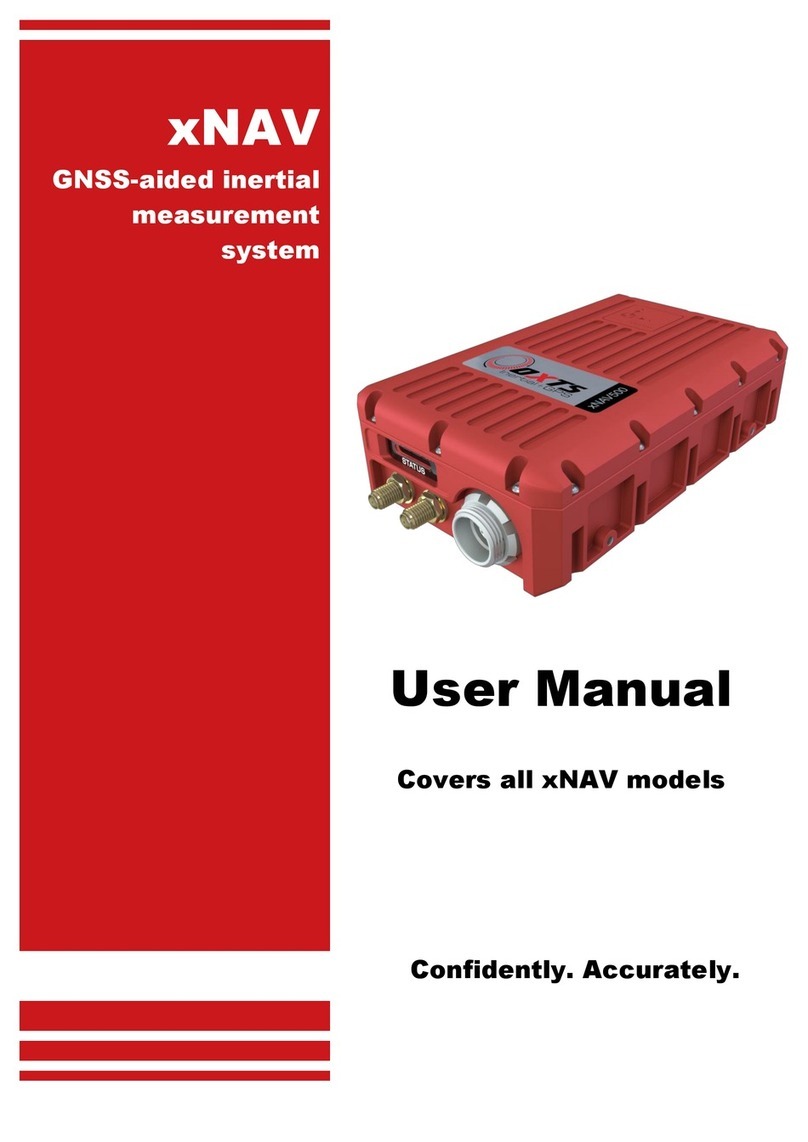
Oxford Technical Solutions
Oxford Technical Solutions xNAV user manual
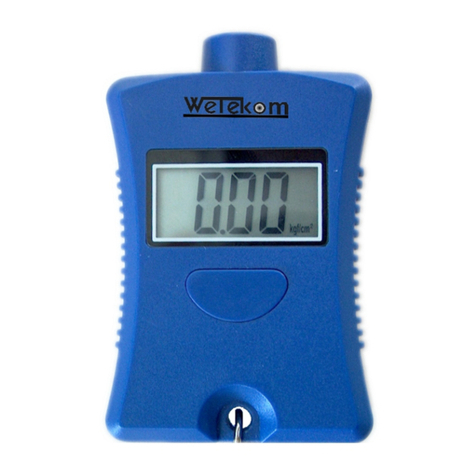
Wetekom
Wetekom 364489 instruction manual
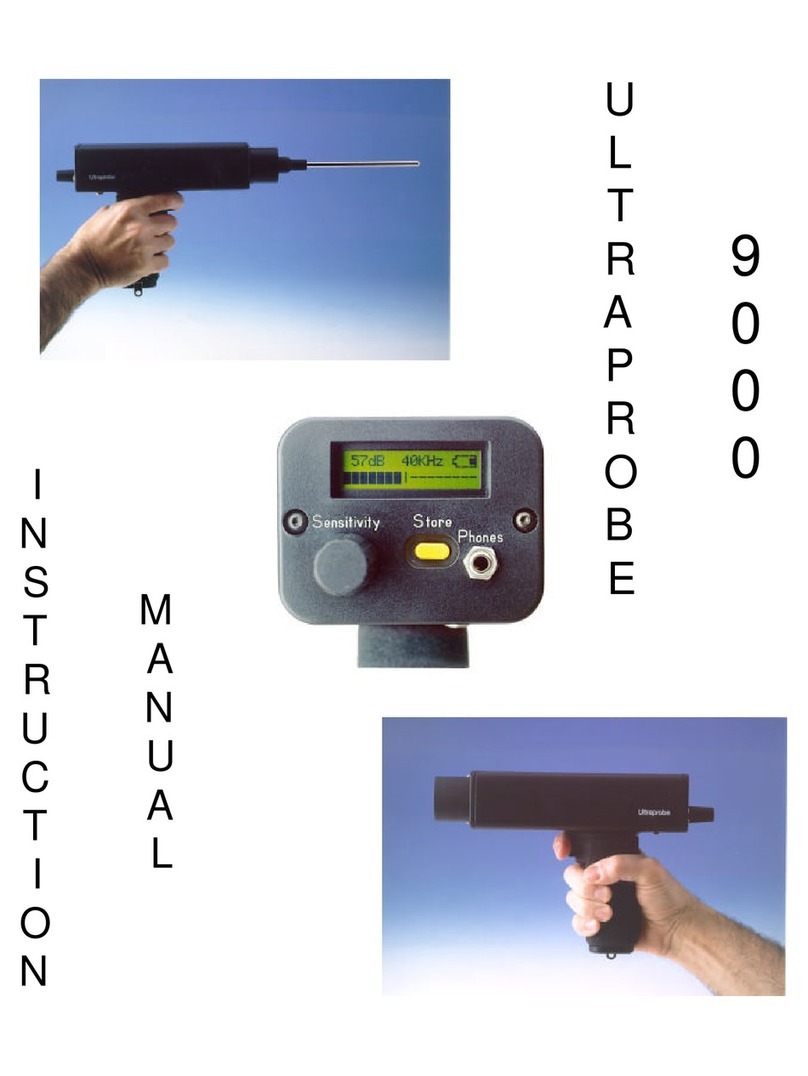
UE Systems
UE Systems Ultraprobe 9000 instruction manual

BELITE ELECTRONICS
BELITE ELECTRONICS RADIANT RFGA-022C Specifications - installation and operation instructions
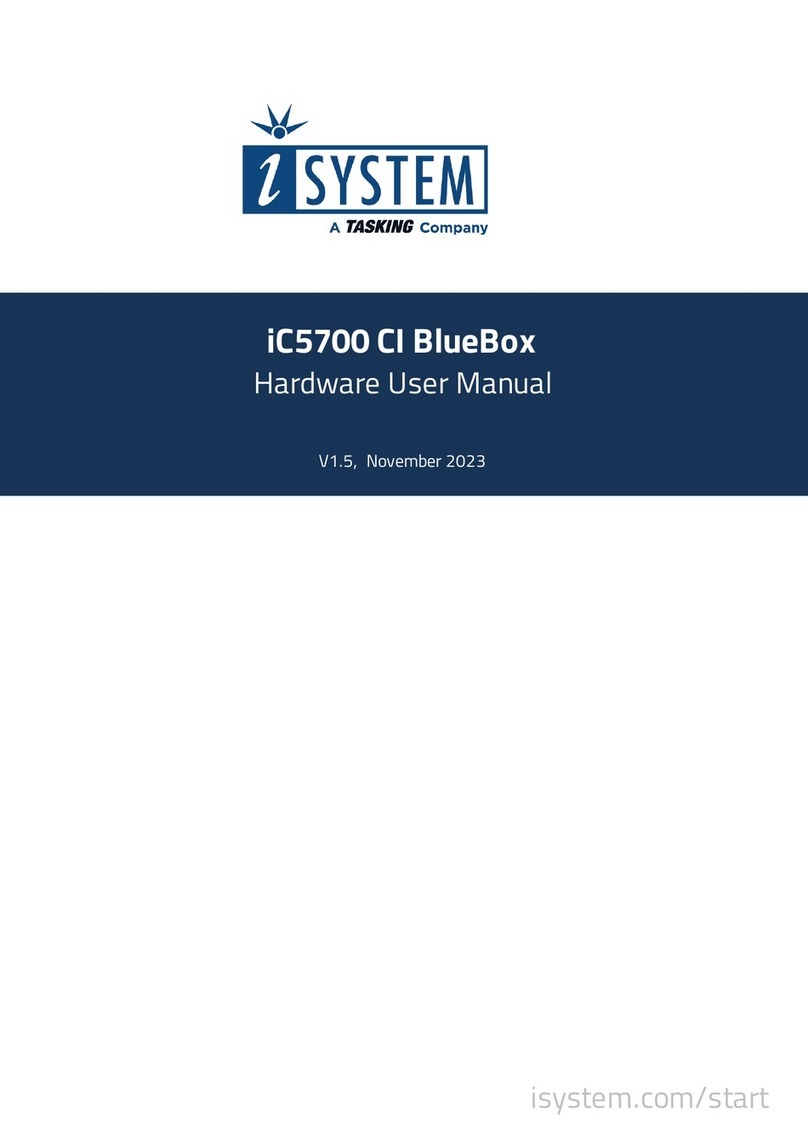
TASKING
TASKING iSYSTEM iC5700 CI BlueBox Hardware user manual

Ocean Optics
Ocean Optics OCEAN FX-UV-VIS user manual
